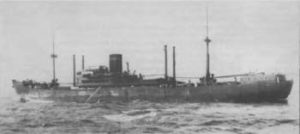- Author
- Clark, Bryan
- Subjects
- History - WW2
- Tags
-
- RAN Ships
- HMAS Sydney II
- Publication
- December 1989 edition of the Naval Historical Review (all rights reserved)
“Regarding an alleged headstone on the grave of the unknown sailor on Christmas Island, the following series were checked: written records (ref. AWM 54). Items 135 Burials, 505 Naval, 622 Australia, 626 Naval Operations. G. Hermon Gill, papers of the Official Historian (ref. AWM 69). Items 23/19 RAN casualties in World War II, 23/20 German and Japanese surface operations, 23/63 and 23/64 Surface raiders parts 1 and 2. I was unable to locate any reference to the headstone in these records.”
Naval Historical Officer (Navy Office), Department of Defence, R. H. Pelvin, June, 1989: “I regret that I am unable to state why the Fremantle War Diary for the period in which you are interested is missing, nor do I have any further information concerning Captain Oldham’s investigation… I believe that any record of an inquest would have been lost in the course of the Japanese occupation of Christmas Island. I have no idea what else might have become of it.”
“My own belief is that the corpse came from HMAS Sydney, as there does not appear to be any alternative source. However, in the absence of further evidence, I do not believe that the mystery will ever be solved.”

From his Hamburg home in West Germany, a former Petty Officer from HSK Kormoran, Mr Otto Jurgensen, commented: “There is no Kormoran survivor who can say that the unidentified sailor on C.I. was one of our men. He must have been a HMAS Sydney man. We had no floats made by Lysaght. I cannot understand the Australian authorities attempts to cover up the truth.”
As Japanese forces occupied Christmas Island between March 31, 1942 (only 53 days after the dead seaman’s body was brought ashore) and August 24, 1945, is it likely that Australian officialdom’s intention to mark the grave site with a headstone was interrupted and ultimately forgotten? Ditto the alleged ‘inquest’?
In April, 1989, the Christmas Island administrator, Mr A. Taylor, sent to the writer a colour photograph purported to be of the ‘unknown grave’. Unlike all other descriptions of it supplied by ex-Island residents, the administrator’s photograph of the grave revealed a concrete border, a big rock at its centre, and, at the head, what appears to be a shattered inscription plate: quite obviously not the grave that has been described by old-time residents as ‘just a mound over-grown with weeds’. Equally as obvious is the belief that Australian officialdom do not know the actual location of the unknown seamen’s last resting place and seem disinterested in locating it much less marking the site with a commemorative headstone or identifying plaque. This is, indeed, a sad indictment against our public service’s apathetic mentality, reinforcing the legend: “There are none so blind as those that do not wish to see.” Nor any as ignorant as those who do not want to know.
Another point: The raft was found in February, 1942; by the size of the barnacles (reported at the time to be ‘six inches long’), it was in the water about three months. By the currents, it had come from the south-south-east. By the markings, it was Australian. The body was still in a state to be identified as ‘Caucasian’. The following ships were sunk in the Indian Ocean by German ships during 1941 (others were taken in prize): (Atlantis): Mandasor: 24 January, 1941. Near equator, about 60 E. (Pinguin): Empire Light: 25 April, 1941. Near Socotra. Clan Buchan: 28 April, 1941. Near Socotra. British Emperor: 7 May, 1941. Near Socotra. (Kormoran): Velebit: 26 June, 1941. Bay of Bengal. Mareeba: 26 June, 1941. Bay of Bengal. Stamatios G. Embiricos: 24 September, 1941. Near equator, about 65E.
From Mareeba and S.G. Embiricos, there were no casualties. There is no way that a life-raft from any of those areas could have drifted to Christmas Island. So, all facts considered, if the unidentified corpse was NOT a HMAS Sydney crewman, from where did it come?




